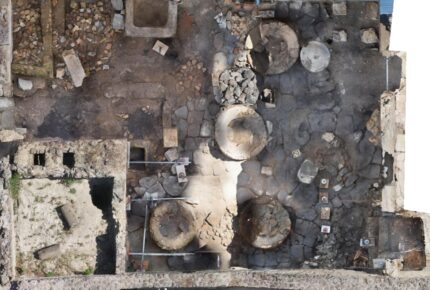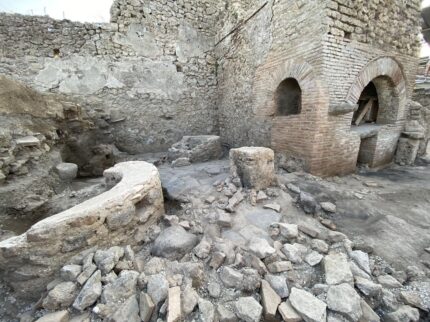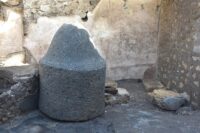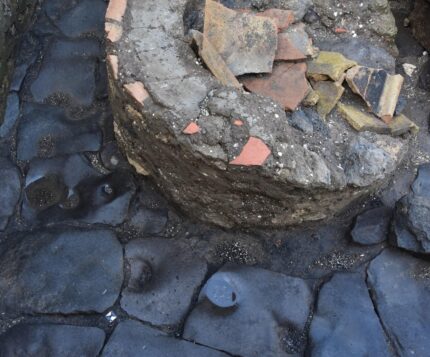 A bakery with a milling operation that attests to the miserable conditions of enslaved people and livestock has been unearthed in a home in Insula X of Pompeii’s Regio IX neighborhood. This is the same home where high-quality Fourth Style frescoes and electoral inscriptions were found earlier this year, evidence that at the time of the eruption, the home with luxurious features also had a very active production area dedicated to bread-making.
A bakery with a milling operation that attests to the miserable conditions of enslaved people and livestock has been unearthed in a home in Insula X of Pompeii’s Regio IX neighborhood. This is the same home where high-quality Fourth Style frescoes and electoral inscriptions were found earlier this year, evidence that at the time of the eruption, the home with luxurious features also had a very active production area dedicated to bread-making.
 The milling and bakery area is located on the west side of the home. The house was built in different phases, and the damage to the walls indicate the production complex dates to the period after the 62 A.D. earthquake. It is composed of four rooms with distinct functions: the bread-making kitchen, the griding area with attached latrine directly connected to the city sewers, a stable for the animals and a room for storage of grain bags. The cooking space was in the northern part of the bakery, distinctly separate from the grinding and animal care area to the south.
The milling and bakery area is located on the west side of the home. The house was built in different phases, and the damage to the walls indicate the production complex dates to the period after the 62 A.D. earthquake. It is composed of four rooms with distinct functions: the bread-making kitchen, the griding area with attached latrine directly connected to the city sewers, a stable for the animals and a room for storage of grain bags. The cooking space was in the northern part of the bakery, distinctly separate from the grinding and animal care area to the south.
 The milling space has a floor covered with paving stones arranged around the five mills. The conical bases of the mills had a hopper mounted on top of it into which enslaved workers poured grain while other slaves and blindfolded donkeys would turn the grinding stone. The room’s tiny windows did not face the outdoors, so cannot have let in much in the way of light.
The milling space has a floor covered with paving stones arranged around the five mills. The conical bases of the mills had a hopper mounted on top of it into which enslaved workers poured grain while other slaves and blindfolded donkeys would turn the grinding stone. The room’s tiny windows did not face the outdoors, so cannot have let in much in the way of light.
The production area that has been uncovered is devoid of doors and communication with the outside world; the only exit leads into the atrium of the house, not even the stable has direct access to the street, as is often the case. “It is, in other words, a space in which we have to imagine the presence of people of servile status whose freedom of movement the owner felt the need to restrict,” notes Director Gabriel Zuchtriegel…. “It is the most shocking side of ancient slavery, the one devoid of both trusting relationships and promises of manumission, where we were reduced to brute violence, an impression that is entirely confirmed by the securing of the few windows with iron bars.”
 The cylindrical masonry structures took up a great deal of room in the restricted space in the room, mills crammed into a very restricted space, making it impossible for two donkeys attached to different mills to pass each other. Instead, they had to synchronize their steps to walk into each other’s gaps. To guide the steps of the animals, semi-circular cutouts were made in the pavers. This had the added advantage of helping the animals not to slip on the smooth volcanic basalt slabs.
The cylindrical masonry structures took up a great deal of room in the restricted space in the room, mills crammed into a very restricted space, making it impossible for two donkeys attached to different mills to pass each other. Instead, they had to synchronize their steps to walk into each other’s gaps. To guide the steps of the animals, semi-circular cutouts were made in the pavers. This had the added advantage of helping the animals not to slip on the smooth volcanic basalt slabs.
“Iconographic and literary sources, particularly the reliefs from the tomb of Eurysaces in Rome, suggest that a millstone was usually moved by a couple consisting of a donkey and a slave. The latter, in addition to pushing the grindstone, had the task of inciting the animal and monitoring the grinding process, adding grain, and collecting the flour.”
The wear on the various indentations can be attributed to the endless cycles, always the same, carried out according to the pattern laid out in the pavement. More than just a groove it reminds us of the gears of a clockwork mechanism, designed to synchronize the movement around the four tightly packed millstones found in this area.